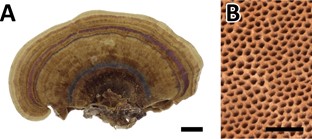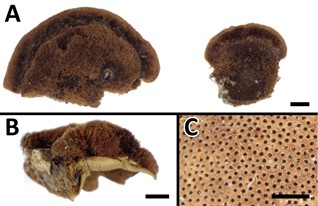Hirticrusta subradiata (Lloyd) Matozaki, T. Hatt. & Sotome, comb. nov. Figs. 2C, 3C, 4.
MycoBank number: MB 834690; Index Fungorum number: IF 834690; Facesoffungi number: FoF;
Basionym: Polyporus subradiatus Lloyd, Mycol. Writ. 4 (Syn. Apus): 346 (1915).
= Neofomitella polyzonata Y.C. Dai, Hai J. Li & Vlasák, Mycotaxon 129: 12 (2014).
= Polystictus neaniscus Berk. ex Cooke sensu Yasuda in Bot. Mag. Tokyo 28: 391 (1914), non Berk. ex Cooke.
Basidiocarps annual, sessile, usually imbricate. Pileus semicircular to dimidiate, applanate, 2–4 cm wide, 2–8.5 cm long, up to 7 mm thick; surface zonate with velutinous zones and glabrous zones, buff to brown (5YR5/4–6, 10YR5–8/4–6) in velutinous zones, dark brown to blackish gray (5YR3–4/1, 10YR3/1) in glabrous zones; margin thin, acute, entire. Context leathery to fibrous-corky, buff (10YR7–8/6), with a crustose layer recognizing in longitudinal section as a dark brown line below velutinous hairs, up to 5 mm thick; tissue darkening with KOH. Pore surface buff to light brown (10YR7–8/6, 5YR6/4–6), glancing, pores round to angular, 4–6(–7)/mm, dissepiments thin, entire.
Tubes concolorous with pore surface, up to 2.5 mm deep. Hyphal system trimitic. Contextual generative hyphae sparse, thin-walled, with clamp connections, hyaline, 2–3.5 µm wide. Contextual skeletal hyphae dominant, unbranched, straight to sinuous, thick- walled to almost solid, light brown, IKI−, 3.5–5.5 µm wide. Contextual binding hyphae sparse, conspicuously branched, almost solid, pale yellow to light brown, IKI−, up to 2.5 µm wide. Tramal generative hyphae sparse, thin-walled, with clamp connections, hyaline, IKI−, 2.5–4 µm wide. Tramal skeletal hyphae dominant, unbranched, straight to sinuous, thick-walled to almost solid, light brown, IKI−, 1.5–2.5 µm wide. Tramal binding hyphae
similar to contextual binding hyphae. Crustose layer in context composed of parallelly and densely arranged, but non-agglutinated hyphae. Cystidia absent. Basidia clavate, 17–23(– 26) × 4–5.5 µm, with 4 sterigmata. Basidiospores hyaline, IKI−, cylindrical, thin-walled, smooth, (4–)5–6 × 1.5–2 µm, 4.8 × 2.1 µm on average, Q = 2–2.75, Qm = 2.27 (n = 30/1).
Distribution: Known from warm temperate areas of China and Japan (Yasuda, 1913, 1914; Ito, 1955; Kigawa, 1996; Ikeda, 2005; Li et al., 2014).
Specimens examined: JAPAN, Hyogo Pref., Kobe, on dead hard wood, leg. T. Matozaki, K. Sotome, M. Nabe, 10 Sep 2016 (TUMH 60638); the same place, on dead hard wood, leg. T. Matozaki, K. Sotome, M. Nabe, the same date (TUMH 60639); Osaka, Takatsuki, Taikoumichi, on hard wood, leg. T. Hattori, 29 Apr 1986, (TFM F-15380); Gumma Pref., Seta-gun, Kotsuke, leg. A. Yasuda, 3 Dec 1911 (holotype: BPI US0306706). Remarks: Ryvarden (1990) incorrectly recognized Polyporus subradiatus as a synonym of Polyporus discipes Berk. [= Fuscoporia discipes (Berk.) Y.C. Dai & Ghob.- Nejh.] based on examination of a Lloyd’s specimen collected from South Africa. This species is characterized by semicircular to dimidiate and zonate pileus with velutinate tomentum on pileus surface, buff context with a thin but persistent crustose layer below tomentum, round to angular pores [4–6(–7)/mm] and cylindrical basidiospores. Ryvarden (1988) concluded that Polystictus neaniscus represents Trametes versicolor (L.) Lloyd without any comments. Despite the colored context of the holotype, we consider that its context was originally white because of the almost hyaline skeletal and binding hyphae in the context. Consequently, we agree with Ryvarden’s conclusion of its identification.

Figs.2

Figs.3

Figs.4
